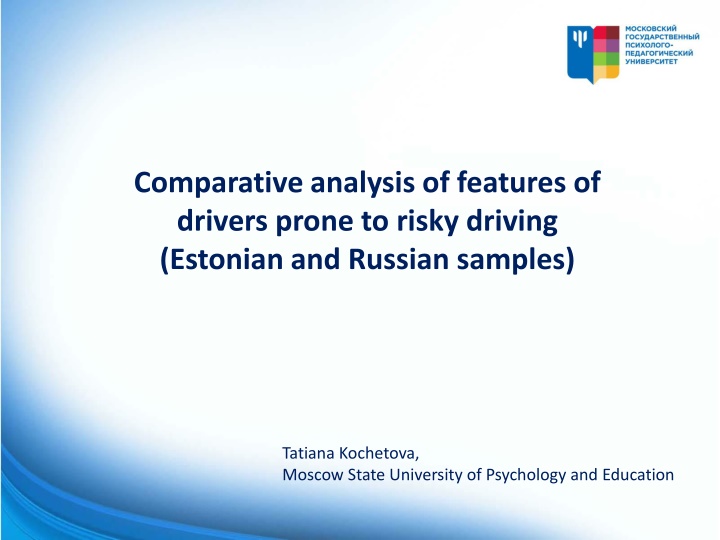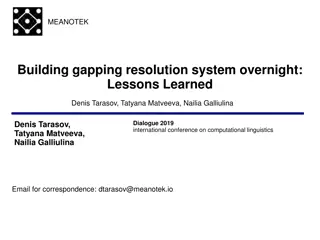
Comparative Analysis of Risky Driving Features in Estonian and Russian Samples
This study by Tatiana Kochetova from Moscow State University compares features of drivers prone to risky driving in Estonian and Russian samples. The research focuses on preventive strategies for drivers with traffic violations, using a model for evaluating risky driving behavior. The study includes a sample of 635 drivers from Estonia and Russia with a history of traffic violations, presenting findings on risky driving indicators and behaviors. The Model used incorporates various factors to assess risky driving, such as risk evaluation, attitudes towards alcohol, and proneness to law violations.
Download Presentation

Please find below an Image/Link to download the presentation.
The content on the website is provided AS IS for your information and personal use only. It may not be sold, licensed, or shared on other websites without obtaining consent from the author. If you encounter any issues during the download, it is possible that the publisher has removed the file from their server.
You are allowed to download the files provided on this website for personal or commercial use, subject to the condition that they are used lawfully. All files are the property of their respective owners.
The content on the website is provided AS IS for your information and personal use only. It may not be sold, licensed, or shared on other websites without obtaining consent from the author.
E N D
Presentation Transcript
Comparative analysis of features of drivers prone to risky driving (Estonian and Russian samples) Tatiana Kochetova, Moscow State University of Psychology and Education
Background of this study and our work 2018 New Road Safety Strategy in the Russian Federation (2018-2024) The main idea is the Vision Zero concept NEED: find a Model for preventive work with drivers who have traffic rules violations
We started to use the Model for behavioural traffic risks evaluation created by Gunnar Meinhard [*] This Model has been implemented in Traffic Offenders Prevention Program in Estonia since 2014 (more than 1.500 courses and more than 25.000 participants) We validated this Model in Russian sample in 2018 year: the main idea was to compare different groups of drivers who had different types of traffic violations * Meinhard G. Klare Sicht !? , Evaluation der Wirksamkeit eines prim rpr ventiven Programmes zur Erh hung der Verkehrssicherheit // WilhelmsUniversit t zu Bonn. 2018. 141 p. Rheinischen Friedrich-
Model description This Model includes several indicators of drivers risky behavior in traffic. These indicators are organized into complex factors - general scales - that characterize risky driving: evaluation of risks and threats in the course of driving attitudes towards alcohol and drink driving (including AUDIT) proneness to violations of law The Model uses Web technologies. Such format allows to give feedback both in group and individually to use it for different solutions in the work with different groups: Personalreport Picture of group of current risk behaviour for preventive work with group
Sample description The general sample included 635 drivers: 465 Estonian citizens (15,5% females, 84,5% males) 170 Russian citizens (38,8% females, 61,2% males) All the research participants had the history of multiple speed violations, as well as the other traffic rules violation Some of the participants of Estonian sample underwent medical checks for drunk driving All results of this study presented here: Meinhard G., Kaart T., Kochetova T.V. Approbation of the model for evaluation of drivers prone to risky driving (Estonian and Russian samples). [Social Psychology and Society], 2018. Vol. 9, no. 4, pp. 119 133. doi:10.17759/sps.2018090411. (In Russ., bstr. in Engl.)
Comparative analysis of means and standard deviations in Estonian and Russian samples Scale (factor) Estonian sample Mean 42.7 Russian sample Mean 52.3 P-value St. Dev. 21.55 St. Dev. 18.3 <0.001 evaluation of driving risks and threats attitudes towards alcohol (including AUDIT) proneness to violations of law The mean on the evaluation of driving risks and threats and proneness to violations of law are significantly higher in the Russian sample while mean on the attitudes towards alcohol scale is significantly higher in the Estonian sample. The mean on the attitudes towards alcohol in Russian sample may be higher if the participants underwent medical checks for drunk driving will be include in it. 21.4 10.16 15.7 12.5 <0.001 12.0 9.91 21.7 14.4 <0.001
Comparative analysis of means in Estonian and Russian samples
Practical solutions for work with different groups (from this study ) The results of testing this Model in Russian sample can be applied to preventive work with Russian citizens as well as for implementing the underlying diagnostic model into the practice of evaluation the risks ( human factor risks on the road) and psychological counselling to prevent traffic accidents The Model can also be used in conducting prevention work that includes trainings, focus-groups, groupwork, etc. We began to use this Model for preventive work with company drivers Now we are beginning to use this Model as a preventive approach in work with a new target group for us - novice drivers
Elements of work with group of novice drivers Personal report and cases in group work I evaluate the hazardousness of speeding over 20 km/h as .. The braking distance in metres from 70 km/h is .. How often in the last 6 months didn t you remember the following morning what had happened the previous night ..
Thank you for your attention! Tatiana Kochetova, e-mal: kochetovatv@gmail.com


